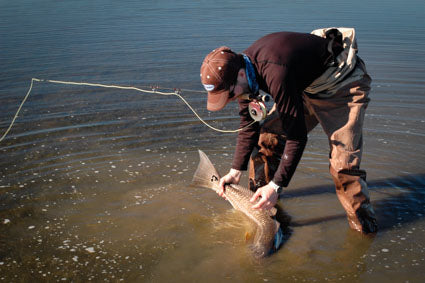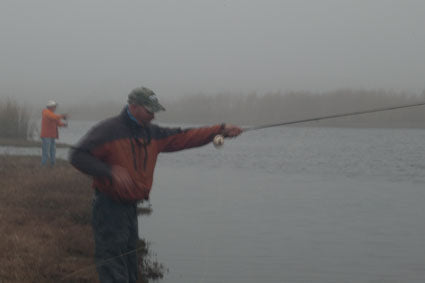There's an impressively large fish within easy casting range. It's been feeding aggressively and has no idea you exist. Maybe it's a big bass in the lily pads, a redfish cruising a shoreline or a permit chasing down crabs. You know you can make the cast but the fly at the end of your leader is all wrong. The color is too dark, it doesn't move right in the water and you're sure the fish won't eat it. The fly you need to have on the end of your line is in a small box in your pocket. Inches away and yet there's no way you can get it tied on in time. You could catch this fish if only you had time to change flies. You make the cast but before the fly hits the water you know the fish will never eat.
 Countless fly patterns and variations are available to those of us who fly fish and yet chances are you gravitate towards a handful of flies. I probably have no less than 20 patterns in my central Florida saltwater boxes and yet I am certain that the next time I head out to chase redfish I will start out using one of three patterns. And, what's more, I am sure that one of these flies will work better than the other 17 patterns in my box. They are my confidence flies.
Countless fly patterns and variations are available to those of us who fly fish and yet chances are you gravitate towards a handful of flies. I probably have no less than 20 patterns in my central Florida saltwater boxes and yet I am certain that the next time I head out to chase redfish I will start out using one of three patterns. And, what's more, I am sure that one of these flies will work better than the other 17 patterns in my box. They are my confidence flies.
We give lots of advice at Orlando Outfitters. One of the most common subjects of this advice is what flies to use for a particular place, situation, time, species etc. The best response is often "whatever fly gives you the most confidence." This is a good answer for many reasons.
Confidence is defined by the Oxford dictionary as "The feeling or belief that one can have faith in or rely on someone or something." In relation to flies we know work, this confidence is well placed. The question is, why?
 Fishermen tend to be more superstitious than some, attributing special powers to a lucky (often very unwashed) hat, fishing spot or fly. Hopefully this is just an act for most of us but I've heard of more than one guide having a fit over the presence of a banana in his boat. I don't think "special powers" is the answer to why some flies work better than others.
Fishermen tend to be more superstitious than some, attributing special powers to a lucky (often very unwashed) hat, fishing spot or fly. Hopefully this is just an act for most of us but I've heard of more than one guide having a fit over the presence of a banana in his boat. I don't think "special powers" is the answer to why some flies work better than others.
To some degree, confidence in a fly is self-perpetuating. If you have confidence that the fly you are throwing will work then you will probably fish it better. You'll cast more accurately, strip more effectively and be ready when the next fish eats. If you don’t feel as good about a fly you may not fish it as well. When a fish shocks you with an eat you will quite likely miss the hookset since you were not prepared. This kind of reinforcement not only helps to increase your confidence in the flies you know work but "proves" that other flies don't work as well.

My friend, Max, and I have been fishing together regularly for over a decade. During a period of several years we spent much of our fishing time targeting oversize redfish. When we first started fishing together my fly of choice was a baitfish pattern. Max, on the other hand, favored a crab fly. I had much more confidence in my baitfish than in his crab and caught many more fish on it. He had the same experience with his crab flies. And each of us was convinced that our fly was the better choice.
As we continued to figure out the fishery and catch fish on our own flies it became obvious that, in the right hands, the flies were equally effective. When I tried a crab fly or Max tied on a baitfish, however, the results were less than stellar. We each caught fish on the other's fly but we were not nearly as effective as when fishing our own flies. A baitfish fished as a crab just doesn't look right and a crab fly scooting energetically across the bottom will send fish running for the edge of the flat.
Over time we figured out that the difference in effectiveness had to do with nuances in how each of us fished the flies. As I began to recognize small changes in the behavior of fish hunting my crab, I became better able to interpret the redfish's mood and action and was able to "feed" the individual fish I was after. I learned where to cast, when to stop and when to give the crab a little bit of animation. I realized that I had been doing this all along with my baitfish patterns but how the fish responded to a crab was much different. Max, on the other hand, got really good at feeding baitfish patterns to these same fish.
I'm convinced that much of the success we see when fishing with our confidence flies has to with the fact that we fish them more effectively than other flies. We know how to make whatever fly we are throwing look like something the fish will want to eat. As we catch more fish with a particular fly, our confidence grows, and we are even more likely to tie that fly on next time we fish. Pretty soon we are masters at fishing a particular fly.

Unless you're just getting started, when you cast you don't think about it. Muscle memory takes over and hopefully the fly follows a tight loop to your target without a conscious thought on your part. Fishing a fly is much the same. You think about where you want the fly to land and certain parts of the retrieve and hook set, but your subconscious mind is making calculations and decisions that you aren't aware of. The flies you have confidence in will be the ones that “just work.” You intuitively know where the fly should land, when to strip and when to let the fish catch its prey.
While It's very much to our advantage to be really good at fishing certain flies, learning to fish other patterns better will open up more opportunities and help us to be better fly anglers. While it is usually possible to find a snook willing to eat a shrimp, there are times when they would prefer a glass minnow or mullet.

When you are fishing any pattern, the bare minimum necessary to catch a fish on it is to get it in the water where the fish live. Sometimes this is enough. The more you are able to make a fly look and act like what you are trying to imitate the more effective it will be. If you are fishing a shrimp fly, think about what that shrimp should be doing. Pay attention to what live shrimp do when they are comfortable in their environment and don't feel threatened. Watch what they do when startled and use this understanding to make a spooked shrimp move away from a gamefish in a lifelike manner. If you're fishing a crab fly, you should understand that crabs tend to dive for the bottom and hide when a predator approaches. Not all baitfish behave the same. Some slide along slowly near the surface. Others dart along the bottom, relying on camouflage to keep them safe. Others swim midwater, speeding up to get away from a predator. Wounded prey is easier to catch so erratic movements with pauses, where the fly sinks awkwardly, are often effective.
A great way to learn to fish different types of flies is to watch others fish their confidence flies. Where are they casting? What is their stripping pattern? Are there any long pauses? Do they let the fly sink before starting to strip? Are they fishing the fly all the way back to the rod tip? How close is the rod tip to the water? Pay attention also, if possible, to how fish seem to respond to their fly as they bring it to life.
If what you are doing is working, keep doing it. And try to remember for next time. If not, don't be afraid to make a change.
Confidence in the fly you are stripping through the water is a great thing and is probably directly related to the number of fish you will catch. It helps to understand where this confidence comes from and why it may help you to catch more fish. Just don’t let your confidence in a few patterns keep you from trying out new patterns and techniques. It’s possible that a pattern that has been relegated to the back corner of your fly box for years may, when fished with confidence, edge out one of your current favorites.















Wes - May 22, 2020
Great post about confidence flies. I have found exactly the same thing to be true. Every year I tie a batch of new patterns to try out, making each one look as much as I can like what my target fish would like to eat. Yet I find myself starting out with one of my new patterns only to go back to my tried and true “confidence” patterns when I don’t get quick results. You have really inspired me to work harder at making my newer experimental patterns become successful. Thanks.